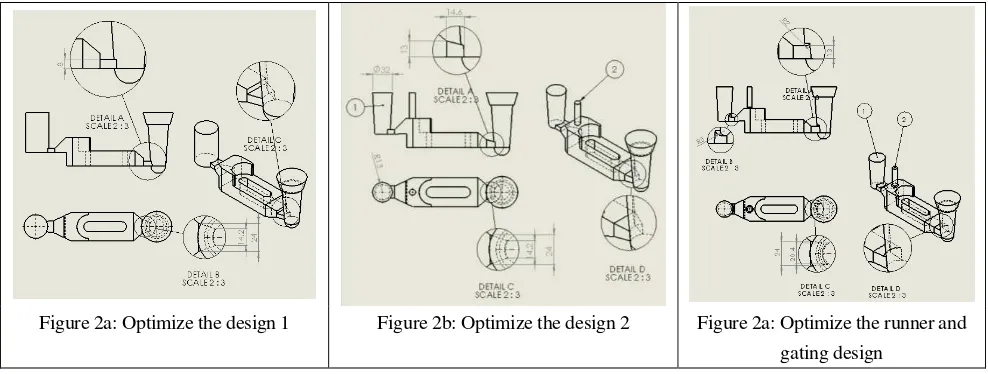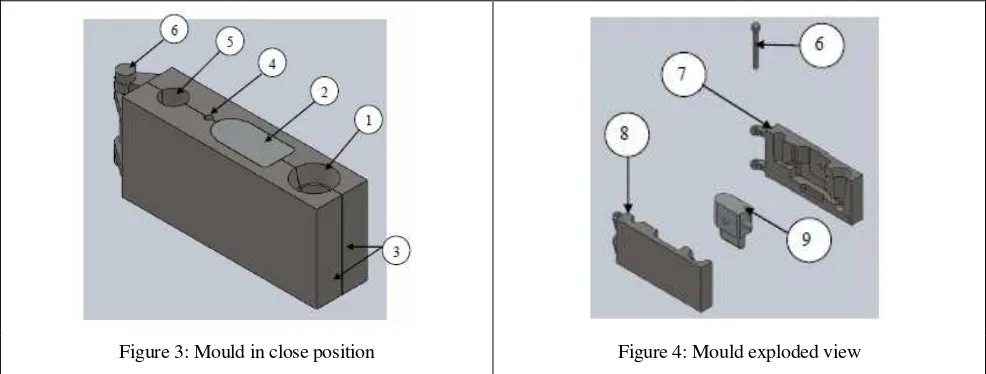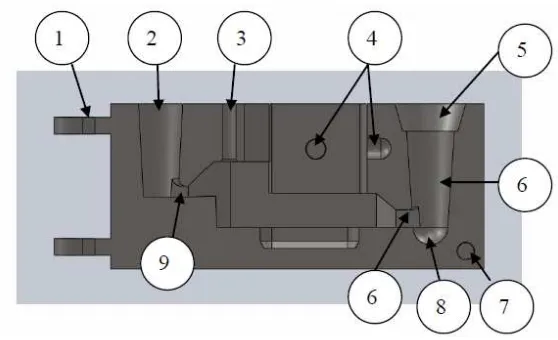日本機械学会 第24回設計工学・システム部門講演会・2014.9.17-19 Copyright (C) 2014 一般社団法人日本機械学会
[No.14-27] 日本機械学会 第24回設計工学・システム部門講演会講演論文集 2014.9.17-19, 徳島県徳島市
2316
Design and optimization of runner and gating systems for permanent mould casting
Taufik RONI SAHRONI
1Mohammad Aizrulshah KAMARUDDIN
2Mohd Shahir KASIM
3Mohd Amran MD ALI
4Effendi MOHAMAD
5Teruaki ITO
61,2,3,4,5
Faculty of Manufacturing Engineering, Universiti Teknikal Malaysia Melaka (UTeM) Hang Tuah Jaya, 76100, Melaka, Malaysia
6
The University of Tokushima, Institute of Technology and Science Minami-Josanjima 2-1, Tokushima-shi, Tokushima, 770-8506 Japan
This paper presents the design and optimization of runner and gating systems for permanent mould casting. Fluid flow effect influences the casting quality. The design parameters for permanent mould casting were identified. The generation of runner and gating system were selected. There were four design concepts to simulate the static pressures, velocity magnitude, turbulence kinetic energy, internal energy and cell Reynolds numbers. Transient and turbulence flow model for LM6 material were applied to the design and simulation. The selection of design concept was introduced. The simulation result shows the design of runner and gating systems good agreement with the casting quality.
Key Words: Design, optimization, runner, gating, permanent mould, casting process, computational fluid dynamic.
1. Introduction
Casting quality has been widely discussed in manufacturing industries due to influences the overall of production cost. Permanent mould casting is a method used to cast a product or part using permanent mould or non-expendable mould unlike sand casting where the use of expendable mould and the flows only at the force of gravity. The benefit of using permanent mould casting is that the high production runs due to faster cooling rate than sand. Permanent mould casting also produces a product with high dimensional accuracy, near net shape and use less raw material. Reasonable price cost can be achieved from the high production rate with metal moulds especially the water cooled moulds compare to sand or investment casting [1].
Defects in sand casting process apply to permanent mould casting such as porosity and shrinkage. Design is the critical step in the development of cost effective and high quality of casting product. In designing a good permanent mould the part geometry plays a big role in effecting the load carrying functionality of the casting and the mould construction [2]. The main purpose of designing the moulds is to concentrate the liquid solid contraction until to the last portion of the casting to solidify [3]. finish. One of the most accepted approaches was using a continuous gating system and a bigger size runner, so the gate
*1, 2, 3, 4
Non-member,Universiti Teknikal Malaysia Melaka (Hang Tuah Jaya, 76100, Melaka, Malaysia ) *5
Member,Universiti Teknikal Malaysia Melaka, Malaysia *6
area was increased and the gating speed was slightly reduced [4]. Gating design was considered in designing of mould, for example as a method of 3D geometries construction [5], angles of the branches [6], and weighting method [7]. Most of the researchers have been applied the gating system for the die casting [4-7]. In December 2013, the authors determined the causes of failures and repairing alternatives in designing of mould and die [8].
Designing of permanent moulds for casting can be considered as art and science. Runners and the gating system are the most important part of the mould. There are numerous guideline can be used for designing a mould but the position and size of the runner and gating depended on the part to be casted. At the moment the current practice in mould construction is an experimenting method where based on trial and error. The trial and error method solely depends on knowledge and experience of design engineers. However, this practice leads time consuming and high cost. This paper presents the Goose neck machine clamp as a case study. The objective of this research is to design and optimisation of runner and gating systems for permanent mould using computer engineering analysis software. The simulation presents the analysis of static pressures, velocity magnitude, turbulence kinetic energy, internal energy and cell Reynolds numbers. Based on the simulation results, the permanent mould was developed.
2. Method
This case study was designed for goose neck machine clamp and was focused on runner and gating systems for permanent mould purposes. There were four design concepts of filling system and followed by concept selection that accommodate the given criteria. Filling system consist of a pouring basin, runner, un-pressurized gating and riser to channel the molten aluminum into the mold cavity. Figure 1a to 1d show the design concept that has been generated. Figure 1(a) shows a conventional design concept that consist of a typical cone pouring basin (1) a tapered sprue (2) and a sprue well (3). Following the casting rule of thumb which is the riser (4) should be located near the thickest part of the product. A design concept was inspired by Campbell in the 10 Rules of Casting [9] as shown in Figure 1b. The design incorporates an offset pouring basin (1), a tapered sprue (2), blind conical riser (3), bottom gate (4), and outflow (5) to allow the molten metal flow in filling the mould. Design concept 3almost similar with design concept 2, except on the position and the shape of blind riser. The position of the blind riser was located directly next to the thickest part of the clamp as shown in Figure 1d. The design incorporates an offset pouring basin (1), tapered sprue (2), conical blind riser (3), trapezoid gating (4), and outflow (5) that indicating the mould was full.
Figure 1c: Design concept 3 Figure 1d: Design concept 4
The filling processes in the mould for every design concepts were simulated using ANSYS 14 Fluent to determine the best design concept. This simulation based on a transient 3 dimensional simulation. The material used in the simulation was Aluminum LM6 with the composition of AL/12Si. The properties are listed in Table 1.
Table 1: LM6 Properties
Properties Value
Density Kg/m^3 2655
Specific heat Cp J/kg k 963
Viscosity Kg/m.s 1.72E-05
Thermal K 142
Solidus temperature K 847
Liquidus temperature K 855
The wall material for simulation was selected steel from ANSYS Fluent Database with density of 8030 kg/m3, specific heat, cp, 502.48 J/kg.K, and thermal conductivity of 16.27 K. The simulation uses the Energy, Viscous and Solidification and melting models. The Cell Zone condition was set to simulate the molten metal of LM6.
3. Results
The data obtained after 250 iterations for each design concept with the identical setup condition. The parameters used in comparing the design were static pressure, velocity magnitude, turbulence kinetic energy and cell Reynolds numbers. Table 2 shows the maximum value comparison from all design concepts. The use of this table is to facilitate the ranking step in order to determine the best design. The lowest value in the table was given 10 marks as the recommendation value and the other value were given an appropriate mark.
Table 2: Maximum value comparison
Parameter Design 1 Design 2 Design 3 Design 4
Static pressure 420601.4 1809604.00 678481.30 1437083.00 Internal Energy 775686.3 775190.30 775617.40 775938.00
Velocity magnitude 16.801 28.68 19.20 19.28
Turbulence K.E 7.92 24.06 8.81 6.13
The ranking shows that the Design 1 has the highest total value of 47.73 marks, and then followed by Design 3 with 36.57 marks, Design 4 with 34.07 marks, and finally Design 2 with 26.01 marks.
Table 3: Ranking
The design selected by ranking stage is the best design which is Design Concept 1. The optimization process changes the dimensional parameters of the Design concept 1. The parameter selected to be optimize is the ingate dimension and shape and open riser dimension and numbers. The optimize runner and gating design are compared to the original design which is Design concept 1.
There were three design optimization can be generated. Figure 2a, 2c, and 2d show the details of design optimization. The runner design incorporates an unpressurized gating design as shown in Figure 2a.The opening gating was a small of 14.2mm wide then opens up 24mm when it reaches the cavity. The design has one open riser with a cross section area of 1256.64 mm2. Figure 2b shows the design with runner and gating system. The gating uses the unpressurized design. The design incorporates 2 open runners, a tapper 32mm diameter and a 10mm diameter straight riser. And the last optimization was runner and gating design as shown in Figure 2c. It incorporates a tapered open riser (2) and a straight 10 mm open riser (2) to act as a vent to reduce the casting defect. The design incorporates the unpressurized gating design. The edge between the sprue and riser was filleted to ensure the flow smoothly. The design parameters of static pressure and velocity magnitude lead the thermal expansion during the filling process into the mould. The temperature of LM6 molten metal into the mould significantly affects the solidification process. It is agreed with the authors that the phenomena of non-linear thermal expansion model for casted aluminum silicon carbide [10, 11]. Thus, the cross section area of runner and gating system influences the casting product [12].
Figure 2a: Optimize the design 1 Figure 2b: Optimize the design 2 Figure 2a: Optimize the runner and gating design
Table 4: Maximum value of design optimization
Parameters Original Optimize 1 Optimize 2 Optimize 3
Static Pressure Pa 420601.4 224586.7 179820.2 40266.36
Velocity Magnitude m/s 16.801 11.867 10.9443 7.84
Internal Energy J 775686.3 775772.3 775870.1 775830.3
Turbulence kinetic energy J 7.92 2.34 3.889 2.35
Cell RE Number 741742 828791.5 727968 547440
The design optimization was modeled using SolidWorks. The mold designed consists of two halves, a pin and a core. Figure 3 shows the designed mold with pouring basin (1), core (2), the two mold halves (3), vent (4), open riser (5) and a pin (6). Rules of thumb to follow, less part count was better. Larger part count will affect the assembly and disassembly time. The mold square outside safe was to provide enough clamping area. The mold designed without any locking or clamping mechanism because it was increased the mould manufacturing cost. Therefore, the mould can be clamped using simple C clamp, vise, or spring clamp. Figure 4 shows the exploded view of the designed mould. It consists of mold halves (7&8), a pin (6) and a core (9).
Figure 3: Mould in close position Figure 4: Mould exploded view
Figure 5: Mould halves features
4. Conclusion
The design evaluated using ANSYS 14 Fluent simulation by comparing four parameters which were the static pressure, velocity magnitude, turbulent kinetic energy, internal energy and cell Renolds numbers. The analysis and ranking method found that Design concept 1 was the best runner and gating design. The design concept was generated by changing the geometry of the runner and gating systems for further design optimization. The optimize runner and gating systems were converted into a 3D modelled for permanent mould. The simulation analysis could predict the condition and outcome from the designed mould.
5. Acknowledgement
The authors acknowledge the Ministry of Education Malaysia for funding this research through the Research Acculturation Collaborative Effort (RACE) Grant Scheme (FRGS (RACE)/2013/FKP/TK2/1 F00198).
6. References
(1) W.A Butler, Die Casting (Permanent Mould). Encyclopedia of Materials - Science and Technology, 1998. (1-11): p. 2147–
2152.
(2) H.W. Stoll, Casting Design Issues and Practices. Casting Design and Performance, 2009. 1(1): p.1–8.
(3) S.Lampman, Casting Design and Processes. Casting Design and Performance, 2009. 1 (1):p. 9–36.
(4) B.H. Hu, K.K. Tong, X.P. Niu, I. Pinwill. Design and optimisation of runner and gating systems for the die casting of
thin-walled magnesium telecommunication parts through numerical simulation. Journal of Materials Processing Technology.
2000. 105:p. 128-133.
(5) S.H. Wu, J.Y.H. Fuh, K.S. Lee. Semi-automated parametric design of gating systems for die-casting die. Journal Computers &
Industrial Engineering. 2007. 53:p. 222-232.
(6) S. Sulaiman, T.C. Keen. Flow analysis along the runner and gating system of a casting process. Journal of Materials Processing
Technology. 1997. 63:p. 690-695.
(7) Sun Z., Hu H., Chen X. Numerical optimization of gating system parameters for magnesium alloy casting with multiple
performance characteristics. Journal of Materials Processing Technology. 2008. 199:p. 256-264.
(8) S. Jhavar, C.P. Paul, N.K. Jain. Causes of failure and repairing options for dies and molds: A review. Engineering Failure
Analysis. 2013. 34:p. 519-535.
(10) T.R. Sahroni, S. Sulaiman, I. Romli, M.R. Salleh, H.A. Ariff, Nonlinear Thermal Expansion Model for SiC/Al, World
Academy of Science, Engineering and Technology, 2011, 5:p. 806-810.
(11) R.S. Taufik, S Sulaiman. Thermal Expansion Model for Cast Aluminium Silicon Carbide. Procedia Engineering. 2013. 68:p.
392-398.
(12) T.R. Sahroni, S Sulaiman. Casting quality model for casted aluminium silicon carbide based on non-linear thermal expansion.




